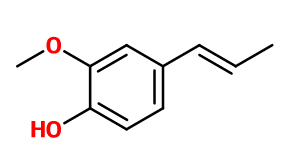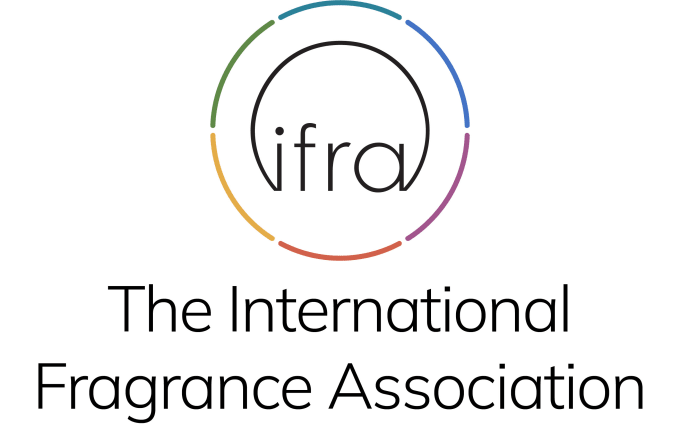
Photo credits: ScenTree SAS
Isoeugenol
2-methoxy-4-prop-1-en-2-ylphenol ; 4-hydroxy-3-methoxy-1-propen-1-yl benzene ; 4- hydroxy-3-methoxy-1-propenyl benzene ; 4- hydroxy-3-methoxypropenyl benzene ; 2-methoxy-4-(1-methylethenyl)phenol ; 2-methoxy-4-(1-methylvinyl)phenol ; 2-methoxy-4-(1-propenyl)phenol ; 3-methoxy-4-hydroxy-1-propen-1-yl benzene ; 2-methoxy-4-propenyl phenol ; 4-propenyl guaiacol

Photo credits: ScenTree SAS
| Company | Ingredient Name | ID | Comments | Naturality | Certifications | Purity | Latin name | Treated part | Geographical origin | MOQ |
|---|---|---|---|---|---|---|---|---|---|---|
|
|
Iso Eugénol - 30 Gr | - |
Visit website
|
- | - | - | - | - | - | |
|
|
Isoeugenol Trans 92% | CL-702 |
Visit website
|
Natural |



|
92 | Eugenia caryophyllus | Clove Oil | Indonesia | 800 Kgs |
|
|
Isoeugenol Trans 88% | CL-701 |
Visit website
|
Natural |



|
88 | Eugenia caryophyllus | Clove Oil | Indonesia | 800 Kgs |
|
|
ISOEUGENOL | M_0053263 |
Visit website
|
Synthétique | - | - | - | - | - |
General Presentation
-
CAS N° : 97-54-1
-
EINECS number : 202-590-7
-
FEMA number : 2468
-
FLAVIS number : 04.004
-
JECFA number : 1260
-
Appearance : Pinkish liquid
-
Density : 1,087
-
Volatility : Heart
-
Price Range : €€
Physico-chemical properties
-
Molecular formula : C10H12O2
-
Molecular Weight : 164,2 g/mol
-
Log P : 2,65
-
Fusion Point : Donnée indisponible.
-
Boiling Point : 270°C
-
Detection Threshold : 100 ppb (0,00001%)
-
Optical rotation : Donnée indisponible
-
Vapor pressure : Donnée indisponible
-
Refractive Index @20°C : Donnée indisponible
-
Acid Value : Donnée indisponible.
-
Flash Point : 112°C
Uses
Uses in perfumery :
Isoeugenol is used in carnation, spicy and ambery notes, often combined with Eugenol. Often replaced by Acetyl-Isoeugenol, unregulated.
Year of discovery :
Data not available.
Natural availability :
In many cases, naturally present Isoeugenol is accompanied by Eugenol, which is present in greater quantities in the following raw materials. Isoeugenol can be extracted from Clove Bud EO (1%), betel leaf (about 10%) or Ylang-Ylang Extra EO, or other fractions (up to 0.5% depending on the fractions).
Isomerism :
Isoeugenol has two diastereomers with a similar smell. It is the mixture of these two isomers that is the most used in perfumery. The trans isomer is nevertheless the most present in this mixture, as it is thermodynamically more stable. Eugenol is an isomer of Isoeugenol, as the double bond present in the two molecules is simply relocated from one molecule to another. Its smell is less fruity but more woody and vanillic. Styrallyl acetate and Frambinone® are examples of constitutional isomers of Isoeugenol. Their smell is however very different.
Synthesis precursor :
Isoeugenol is a precursor to the synthesis of several compounds of olfactory interest. Catalytic hydrogenation of the molecule allows to obtain Dihydoeugenol. In the past, Vanillin was produced by an oxidation reaction on Isoeugenol. The alcohol function of the molecule can finally be used for several esterification reactions, to obtain Isoeugenyl acetate for example.
Regulations & IFRA
Allergens :
This ingredient does not contain any allergen.
IFRA 51th :
This ingredient is restricted by the 51th amendment
- Quantitative limit on the use :
-
Cat.1 Cat.2 Cat.3 Cat.4 Cat.5A B C DCat.6 0,019 % 0,0057 % 0,12 % 0,11 % 0,027 % 0,027 % 0,027 % 0,009 %0,063 % Cat.5A B C DCat.6 0,027 % 0,027 % 0,027 % 0,009 %0,063 % Cat.7A BCat.8 Cat.9 Cat.10A BCat.11A BCat.12 0,22 % 0,22 %0,009 % 0,21 % 0,21 % 0,75 %0,009 % 0,009 %No Restriction Cat.10A BCat.11A BCat.12 0,21 % 0,75 %0,009 % 0,009 %No Restriction
Annexe I :
Some regulated synthetic ingredients are found in nature and in certain proportions in natural ingredients. This presence in nature has to be taken into account when calculating limits of use recommended by the IFRA. In case you do not know these concentrations, you can use the ones estimated by the IFRA. Here they are :
| List of regulated compounds contained in this ingredient | |||
|---|---|---|---|
| Ingredient Name | Botanical Name | CAS N° | Estimated Concentration |
| Cinnamon bark CO2 extract | Cinnamomum verum J. Presl syn. C. zeylanicum Blume | 8015-91-6 | 0,05 |
| Cinnamon bark oil | Cinnamomum zeylanicum Blume | 8015-91-6 | 0,02 |
| Cinnamon leaf oil | Cinnamomum zeylanicum Blume | 8015-91-6 | 0,13 |
| Cassia bark oil | Cinnamomum cassia [L.] J. Presl syn. C. aromaticum Nees | 8007-80-5 | 0,1 |
| Cassia oil | Cinnamomum cassia [L.] J. Presl syn. C. aromaticum Nees | 8007-80-5 | 0,1 |
| Champaca absolute | Michelia champaca L. | 8006-76-6 | 0,03 |
| Clove leaf oil | Syzygium aromaticum L. | 8000-34-8 | 0,1 |
| Jasmine grandiflorum absolute | Jasminum grandiflorum L. | 8022-96-6 | 0,12 |
| Lemongrass oil, East Indian | Cymbopogon flexuosus (Nees ex Steudel) Will. Watson | 8007-02-1 | 0,47 |
| Lemongrass oil, West Indian | Cymbopogon citratus (DC) Stapf. | 8007-02-1 | 0,5 |
| Lovage root oil | Levisticum officinale Koch | 8016-31-7 | 0,06 |
| Nutmeg oil | Myristica fragrans Houtt. | 8008-45-5 | 0,5 |
| Pine Scotch, resinoid | Pinus sylvestris L. | 0,01 | |
| Tuberose absolute | Poliantes tuberosa L. | 8024-05-3 | 1,5 |
| Tuberose concrete | Poliantes tuberosa L. | 8024-05-3 | 1,5 |
| Ylang ylang oil I | Cananga odorata (Lam.) Hook. f. &Thomson oil (forma genuine Steenis) | 8006-81-3 | 0,51 |
| Ylang ylang oil II | Cananga odorata (Lam.) Hook. f. &Thomson oil (forma genuine Steenis) | 8006-81-3 | 0,24 |
| Ylang ylang oil III | Cananga odorata (Lam.) Hook. f. &Thomson oil (forma genuine Steenis) | 8006-81-3 | 0,54 |
| Ylang, Ylang oil complete | Cananga odorata (Lam.) Hook. f. &Thomson oil (forma genuine Steenis) | 8006-81-3 | 0,52 |
| Ylang, Ylang oil extra | Cananga odorata (Lam.) Hook. f. &Thomson oil (forma genuine Steenis) | 8006-81-3 | 0,99 |
| Clove bud absolute | Syzygium aromaticum (L.) Merr. & L.M.Perry | 616-772-2 | 0,01 |
| Jasmine officinale absolute | Jasminum officinale L. | 8024-43-9 | 0,1 |
| Ylang-ylang absolute | Cananga odorata (Lam.) Hook.f.&Thomson forma genuina | 0,5 | |
| Benzoin resinoid, Siam | Styrax tonkinensis (Pierre) Craib ex Hartwick | 0,1 | |
| Benzoin resinoid, Sumatra | Styrax benzoin Dryand. | 0,01 | |



